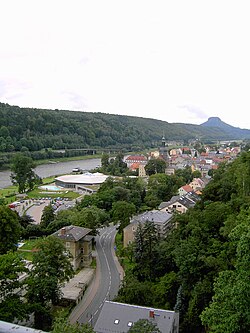Krippen
| Bad Schandau | ||
|---|---|---|
 |
||
|
||
| Coordinates: 50°55′N 14°9′E / 50.917°N 14.150°ECoordinates: 50°55′N 14°9′E / 50.917°N 14.150°E | ||
| Country | Germany | |
| State | Saxony | |
| District | Sächsische Schweiz-Osterzgebirge | |
| Municipal assoc. | Bad Schandau | |
| Government | ||
| • Mayor | Andreas Eggert | |
| Area | ||
| • Total | 46.77 km2 (18.06 sq mi) | |
| Elevation | 146 m (479 ft) | |
| Population (2015-12-31) | ||
| • Total | 3,761 | |
| • Density | 80/km2 (210/sq mi) | |
| Time zone | CET/CEST (UTC+1/+2) | |
| Postal codes | 01812–01814 | |
| Dialling codes | 035022 | |
| Vehicle registration | PIR | |
| Website | www.bad-schandau.de | |
Bad Schandau (German pronunciation: [ˈbaːt ˈʃandaʊ], Czech: Žandov) is a spa town in Germany, in the south of the Free State of Saxony and the district of Sächsische Schweiz-Osterzgebirge. It is situated on the right bank of the Elbe, at the mouth of the little valley of the Kirnitzsch.
Bad Schandau lies east of the Elbe right on the edge of the Saxon Switzerland National Park in the Elbe Sandstone Mountains; the National Park Centre is located in the town. The original town centre nestled on the steep, towering sandstone rocks on the right-hand, northern bank of the River Elbe and squeezed in places into the narrow valley of the Kirnitzsch. The town centre lies 121.7 m above sea level (HN) (market square), whilst its highest points lie over 400 metres above sea level. A rural tram line, the Kirnitzschtal Tramway, accompanies the little river for several kilometres and offers access to the nearby walking area.
Bad Schandau is about 6 kilometres from the Czech frontier and 33 km southeast of Dresden on the railway to Děčín.
The borough of Bad Schandau consists of the original old town of Schandau and 5 newer quarters: Krippen, Postelwitz, Schmilka, Ostrau and Porschdorf. Krippen lies on the opposite bank of the Elbe.
The original craftsmen's and merchants' settlement left of the Elbe with surviving timber-framed houses that were mentioned as early as 1379 has been a summer resort since the end of the 19th century, when development of tourism began. The village was the sphere of action of the Krippen villager and inventor of mechanical wood pulp for the manufacture of paper, Friedrich Gottlob Keller (1816–95), from 1853 to his death. A memorial tablet on the Keller Museum, house number 76 in the main road named after him and in which the inventor once lived, celebrates him and his work. In 2009, Krippen had a population of 568 (1999: 720).
...
Wikipedia




